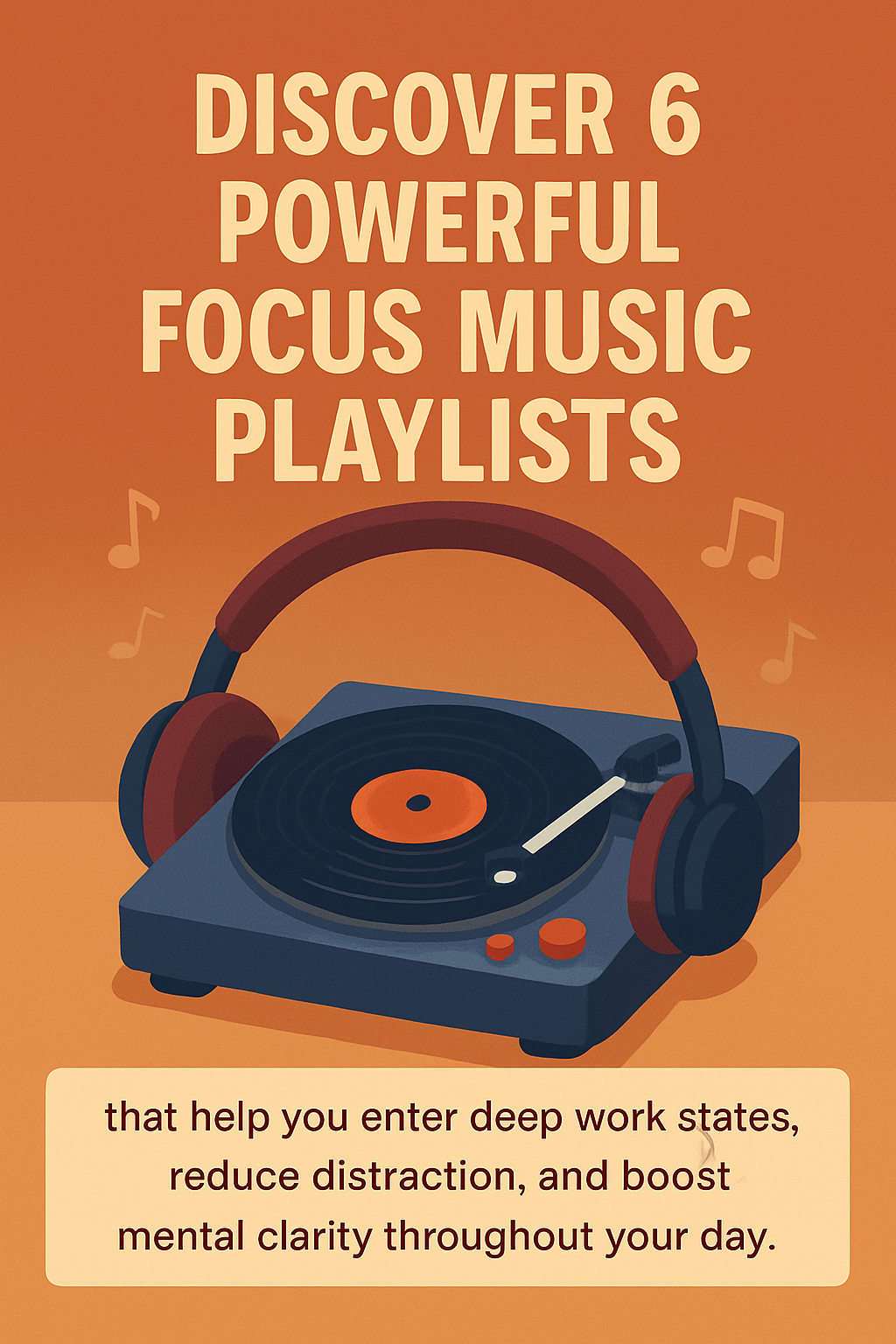Focus music playlists are not background sound — they’re neuro-designed systems that reshape your cognitive rhythm.
Whether you’re studying, coding, writing, or just trying to reduce digital noise, using the right focus music playlists can be the difference between shallow scrolling and real traction. This guide breaks down six curated playlists that actually enhance focus — based on user behavior, musical structure, and neurological research.

Why Focus Music Playlists Enhance Deep Work
The brain is constantly scanning for stimuli — a survival feature that’s now hijacked by apps, notifications, and background noise. Focus music playlists counter this by creating a predictable audio environment that the brain quickly tunes into and then tunes out. That’s where deep focus starts.
Research shows that ambient and instrumental music can decrease anxiety and increase time-on-task. But it only works when the music fades into the background. This is why structured playlists — like Deep Focus or Brain Food — are far more effective than personal favorites with lyrics or fluctuating energy.
Using these focus music playlists consistently builds a habit loop: headphones go on, your brain recognizes the signal, and you slip into concentration faster. That association becomes a cognitive shortcut — and eventually, a productivity trigger.
Deep Focus and the Power of Sonic Stillness
Deep Focus (Spotify) is built for flow. The playlist is composed of ambient, low-frequency tracks with little to no percussion. There’s a reason it has over 8 million followers — it works. When you play Deep Focus, your mind gradually lowers its alertness to external distractions, allowing immersion to take over.
Unlike energetic music, this playlist doesn’t try to push you — it lets you settle. That calmness becomes the foundation for high-cognitive tasks like writing or problem-solving. The sonic environment is neutral, consistent, and intentionally uneventful — which is exactly what your brain needs to stop jumping between thoughts.
Lo-Fi Beats and Rhythmic Habit Loops
Lo-Fi Beats are more than trendy — they’re structurally perfect for mid-level cognitive tasks. The genre uses repetitive loops, mellow instrumentation, and low BPMs. This repetition creates a rhythm that mirrors natural focus cycles, especially when doing creative or semi-automatic tasks like note-taking or designing.
Channels like Lofi Girl and Chillhop built massive audiences because their streams reduce stimulation without dulling energy. Lo-fi beats act as a soft buffer between you and digital chaos — they smooth out your mind without putting it to sleep.
Brain Food and the Cognitive Edge of Sound Design
Brain Food (Spotify) is an intentionally curated electronic playlist made for alert productivity. It has more energy than ambient tracks but is carefully restrained to avoid overstimulation. For problem-solving or technical work, this playlist sustains alertness without tipping into stress.
Its strength lies in frequency selection — subtle mid-frequency patterns help maintain attentional engagement while avoiding auditory fatigue. Brain Food is especially effective during mentally intensive stretches when silence isn’t enough, but distraction would be too much.
Classical Concentration and the Legacy of Focus
Classical Concentration (Spotify) proves that the right classical music can boost brain function. Studies link classical compositions — particularly those without vocals — to improved memory recall, reduced cortisol levels, and enhanced cognitive performance during long study blocks.
This playlist carefully selects non-disruptive works, avoiding dramatic crescendos or erratic tempo changes. It’s ideal for academic tasks, legal review, or any scenario where calm and precision matter. The long-form compositions help regulate pacing and improve time perception.
🎧 Stream Classical Concentration
Focus Flow and Momentum Without Lyrics
Focus Flow blends cinematic scores, light electronica, and minimalist beats to maintain forward movement. It’s designed for people who want structure without silence. Unlike traditional ambient playlists, this one maintains motion — perfect for tasks requiring energy without hype.
Designers, UX professionals, and writers often report that lyric-free music like Focus Flow helps them enter and sustain flow states. The playlist helps you start strong — and more importantly, helps you keep going when energy dips.
Do Focus Music Playlists Work for Everyone?
While focus music playlists are widely praised for their benefits, not every brain responds the same way. Some people thrive in complete silence, while others enter flow only with sonic stimulation in the background. What matters is how your mind reacts during real work sessions.
If a playlist enhances your ability to stay on one task longer, reduces the urge to check your phone, or helps you ignore ambient distractions — it’s doing its job. The best focus music playlists aren’t necessarily the most popular ones. They’re the ones that match your energy, task type, and cognitive style.
We suggest experimenting for 2–3 days with each option. Over time, your brain will associate specific playlists with deep work states. That’s when focus music playlists stop being a trick — and start becoming a personal system for productivity.
Binaural Beats and Frequency-Driven Focus
Binaural beats operate on a different mechanism: they use two slightly different frequencies in each ear to create brainwave entrainment. Though scientific results are mixed, many users report improved concentration and reduced anxiety after just 10 minutes of listening.
This technique is particularly effective for users prone to distraction or stress. The beats work best with noise-canceling headphones and are often used in short bursts (15–30 minutes) to reset focus or induce a deep work state.
🎧 Watch Binaural Beats on YouTube
Final Thoughts
Focus music playlists aren’t just ambiance — they’re strategic tools. When matched with your task type and brain’s state, they create a sonic scaffolding for high-output work. The six playlists above cover a wide spectrum of needs: calming, energizing, rhythmic, immersive.
Test a few. Use one consistently for a week. You’ll quickly see that the right focus music playlist doesn’t just help you work longer — it helps you work better, deeper, and more sustainably.
Ready to Take Action?
Start applying these insights today — and discover what real focus feels like.
